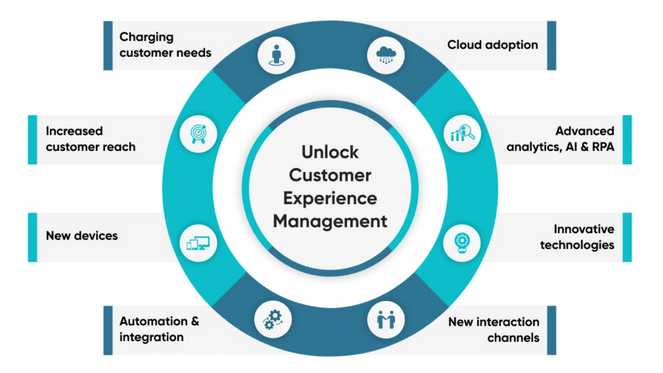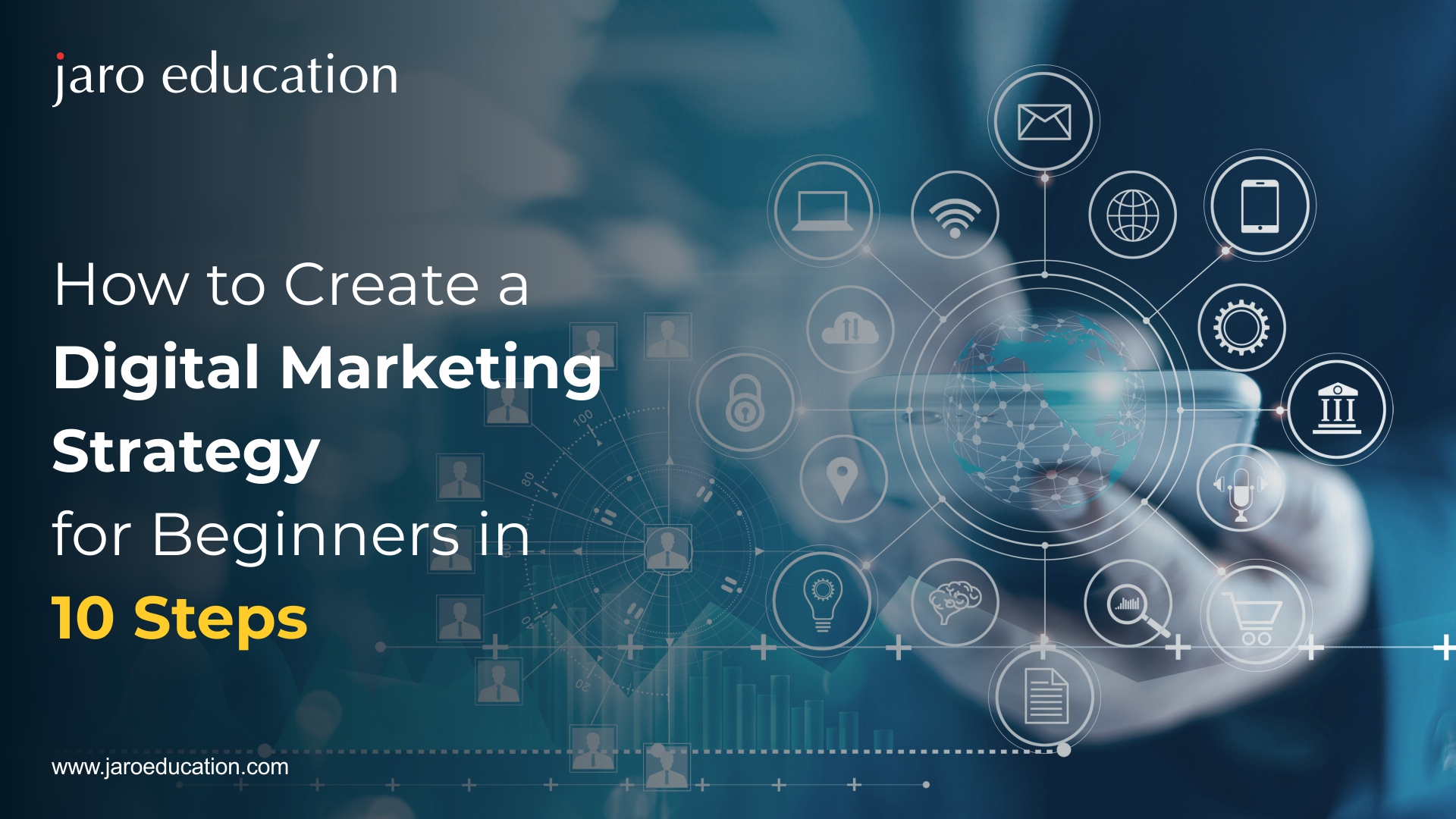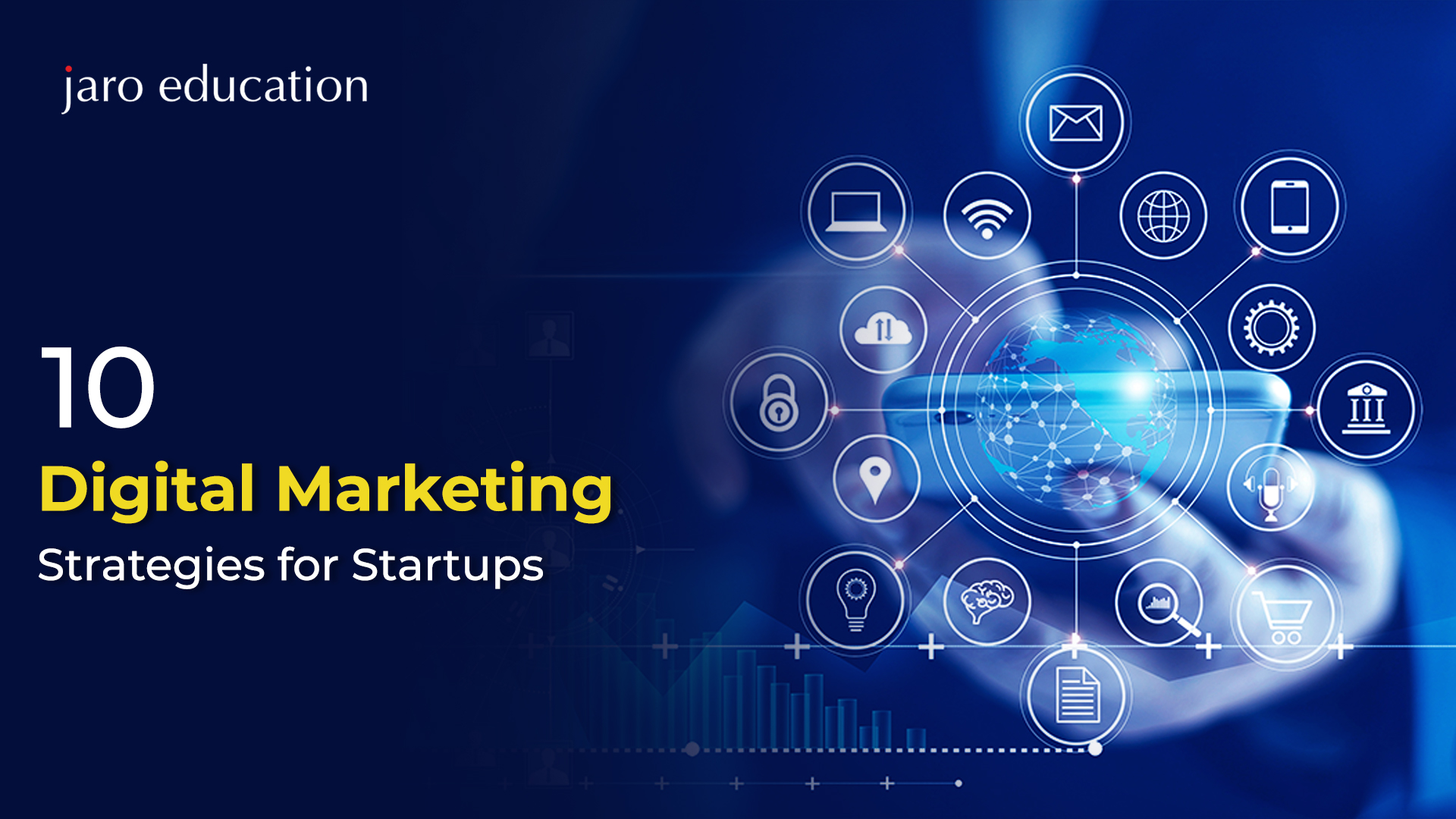
- jaro education
- 25, February 2024
- 10:00 am
For a successful business, there’s one big thing that really matters: making customers happy. It’s not just about selling stuff – it’s about giving customers a great experience. Successful businesses don’t just sell things; they put customers right in the middle of everything. How? By talking to customers, understanding what they need, and caring about what they think. This customer-focused way of doing things has a special ingredient: listening. Listening to what customers say helps businesses understand what people like about their products and services. It also gives insights into what customers want and expect.
This whole process of gathering and using customer feedback to make them even more satisfied is called customer experience management. In this blog, we’re going to break down what customer experience management is, why it’s so important, how it works, and what makes it different from customer relationship management. We’ll even explore some tools to make your business’s customer experience top-notch.
What is Customer Experience Management?
Customer experience management, commonly denoted as “CXM” or “CEM,” encompasses a set of strategies, techniques, and tools aimed at enhancing the overall customer experience.
A customer, surrounded by individuals dedicated to improving her experience, illustrates the essence of CXM. Despite its broad scope, CXM is crucial in the business realm. In the subsequent sections, we will acquaint you with the fundamental aspects of customer experience, its management, its significance, and its distinctions from customer relationship management.

Table of Contents
*netsolutions.com
Understanding Customer Experience
Customer experience pertains to the comprehensive encounter a customer has while interacting with your company. This involves various facets such as engaging with marketing communications, navigating your website, and completing a purchase, among other interactions.
Breaking down the intricacies of customer experience reveals three primary categories:
1. Engagement
This revolves around the extent to which customers interact with your company. Engagement manifests in diverse forms, including opening marketing emails, participating on social media platforms, and making purchases. Encouraging and tracking customer engagement is a vital objective in CXM.
2. Satisfaction
Assessing whether customers are content with their experiences is critical. Even engaged or purchasing customers may not always be satisfied, and discontent can deter them from returning. While gauging and maintaining customer satisfaction poses challenges, it remains a central goal in CXM.
3. Experience
The overall encounter forms the basis for both customer engagement and satisfaction. Despite its apparent simplicity, maintaining focus on the holistic experience becomes challenging amidst meticulous tasks like crafting the perfect email or optimizing an online store.
While customer experience is commonly defined as the amalgamation of engagement, satisfaction, and experience, the composition of this combination varies significantly across companies, industries, and individual customers. Consequently, each customer experience is distinctive, demanding a tailored approach and management methodology.
Why is Customer Experience Management so Important?
Making an investment in your customer experience holds significant importance for various reasons. Apart from the direct impact on sales and the establishment of a positive reputation, CXM also aids in refining your business by identifying and addressing the needs and values of your customers. The overall prosperity of every aspect of your business is closely tied to the satisfaction of both customers and employees. Here are some statistics and benefits of customer experience that will help you to understand why it is so important.
- Companies earning $1 billion annually can anticipate an average additional revenue of $700 million within three years of investing in customer experience.
- SaaS companies, in particular, can foresee a revenue increase of $1 billion through effective customer experience management.
- Customers demonstrate a willingness to pay a price premium of up to 13% (and even as high as 18%) for luxury and indulgence services when they receive an outstanding customer experience.
- Customer experience (CX) also has a direct impact on on-the-spot purchasing, with 49% of buyers making impulse purchases after experiencing a more personalized customer experience.
- Understanding your customers’ preferences and dislikes can be challenging, even with the use of surveys. However, with Customer Experience Management (CXM), you can obtain valuable “covert” feedback by directly observing their actions, providing insights beyond what surveys may reveal.
- Through CXM, you have the capability to closely track customer activity, enabling the direct observation of the impact of marketing campaigns and other initiatives.
- Implementing a straightforward CXM strategy positions you ahead of competitors. As you progressively enhance customer satisfaction and reduce customer churn over time, you secure a lasting advantage in the marketplace.
Difference Between CXM and CRM
| Criteria | Customer Experience Management (CXM) | Customer Relationship Management (CRM) |
|---|---|---|
| Core Objective | Develops a holistic, qualitative strategy across multiple channels based on customer interaction data. | Focuses on the customer's value to the company, primarily dealing with quantitative insights. |
| Data Emphasis | Utilizes data to create a comprehensive, qualitative understanding of customer experiences. | Primarily concerned with quantitative data, such as click-through rates and transaction history. |
| Insight Focus | Concentrates on qualitative customer insights, aiming to understand and enhance the customer experience. | Concentrates on quantitative insights, emphasizing the numerical value of customer interactions. |
| Process Improvement | Prioritizes external processes, especially customer engagement, to enhance overall customer satisfaction. | Concentrates on internal processes, aiming to streamline company operations and improve efficiency. |
| Utilization of CRM Data | Leverages CRM data to anticipate customer needs and provide real-time solutions. | Uses CRM data as a foundation for understanding customer value but may not focus on real-time solutions. |
Strategies for Good Customer Experience Management
To comprehend and oversee customer experience effectively, CX professionals need to cultivate expertise in skills such as refining their strategic perspective and adopting a data-driven mindset. Individuals aiming to embark on a career in customer experience or stay abreast of the latest CX trends should consider obtaining a customer experience certification to gain recognition for their proficiency.
Effectively managing customer experience across the entire customer journey involves the following:
1. Content Generation
Producing supportive research, marketing materials, and sales enablement content provides each team with avenues to demonstrate value to customers. Brands can enhance this by personalizing customer-facing content, spanning emails, text messages, website content, and mobile apps, thereby enhancing relevance and customer engagement.
2. Evaluating Customer Sentiment
CX teams should continuously collect the voice of the customer data to pinpoint areas for improvement in experiences. Simply having this data is insufficient; brands should comprehend customer emotions using sentiment analysis tools and techniques.
3. Creating Customer Personas and Marketing Segments
Recognizing that different customer groups have distinct needs, brands should ensure a consistent, engaging experience by addressing and anticipating these diverse requirements.
4. Investing in Customer Loyalty Programs
Acknowledging frequent customers with savings and perks fosters loyalty. Well-executed loyalty programs not only provide acknowledgement but also drive up-sell revenue.
5. Evaluating Customer Touchpoints
Understanding where customers make purchasing decisions and identifying potential points of customer attrition is crucial. This insight allows brands to continually refine their customer experience and prevent customers from turning to competitors.
6. Analyzing Customer Data
Chief Experience Officers should utilize Voice of the Customer (VoC) data alongside customer analytics tools to iteratively implement improvements based on customer feedback.
These are just a glimpse of what you can learn with the Advanced Programme in Digital Marketing from IIM Ahmedabad. In this programme, participants will acquire in-depth insights to make well-informed decisions pertaining to the development and assessment of digital strategies. This knowledge will empower them to seamlessly integrate various functions within digital marketing, refining their overall marketing mix.
Challenges in Customer Experience Management (CXM)
Numerous hurdles can impede the achievement of a successful customer experience. Here are eight key challenges that organizations may encounter:
Insufficient Voice of the Customer Data
Difficulty in accurately measuring customer experience without substantial datasets, leading to an inability to address unnoticed problems in customer experience.
Lack of Omnichannel Support
Brands face challenges when they cannot engage with customers on the channels they prefer, risking customer defection to competitors due to a failure to listen and assist through various channels.
Ignoring Qualitative Data
Neglecting the harvest and analysis of individual comments in survey free-text fields and overlooking the value of qualitative data, provides a deeper understanding of customer experience issues compared to numerical ratings.
Poor Internal Communications
A need for effective communication within the CX team and across other departments to ensure that insights derived from analyzing customer journeys and VoC programs are shared comprehensively with stakeholders in sales, marketing, customer support, and senior leadership.
Organizational Silos
Difficulty in understanding customer behavior due to separate databases in sales and marketing, resulting in CX teams working with incomplete data that distorts the reality of a customer’s experience.
Insufficient Tools and Technology
CX teams face limitations without proper tools for data gathering, analysis, and implementation of changes. Utilizing a CXM platform and customer journey mapping tools can enable real-time response to customer concerns, measurement of customer loyalty, and tracking of sales efforts.
Outdated Documentation
The challenge of relying on outdated data renders the extensive gathering and analysis of customer data useless for CX teams. Current and accurate data is crucial for the success of CX initiatives.
Unclear ROI
The challenge of justifying the commitment and investment in a CX strategy to the C-suite, emphasizing the importance of calculating CX ROI to instill confidence among leadership that dedicating time and resources to the customer experience is a worthwhile endeavor.
Tools for Effective Customer Experience Management
Managing customer experience may necessitate the utilization of various tools for your business. Here are some common types of software and tools dedicated to customer experience management (CXM) that can streamline the CXM process:
CRM Software
Purpose
CRM software assists businesses in managing interactions and relationships with customers. It centralizes customer data, tracks communication, and streamlines sales and support processes.
Use Cases
Managing leads, tracking customer interactions, handling support tickets, and analyzing customer data.
Examples
Salesforce, HubSpot, Zoho CRM.
Feedback and Survey Tools
Purpose: These tools facilitate the collection of feedback from customers through surveys, questionnaires, and feedback forms, contributing to successful customer experience management.
Use Cases: Gauging customer satisfaction, understanding preferences, and identifying areas for improvement.
Examples: Zonka Feedback, Typeform, Qualtrics.
Customer Support Platforms
Purpose
Designed to provide efficient and timely support through various channels, including email, chat, and phone.
Use Cases
Handling customer inquiries, resolving issues, and managing support tickets.
Examples
Zendesk, Freshdesk, Help Scout.
Analytics and Reporting Tools
Purpose
Analytics tools assist businesses in analyzing customer behavior, preferences, and interactions on digital platforms.
Use Cases
Tracking website traffic, customer engagement, and conversion rates to make data-driven decisions.
Examples
Google Analytics, Mixpanel, Hotjar.
Social Media Listening Tools
Purpose
These tools monitor and analyze social media platforms for brand mentions, feedback, and industry trends.
Use Cases
Responding to customer inquiries, managing brand reputation, and staying informed about market sentiment.
Examples
Hootsuite, Brandwatch, Sprout Social.
Customer Journey Mapping Tools
Purpose
Visualizing and mapping the customer journey helps businesses understand touchpoints and customer interactions.
Use Cases
Identifying key touchpoints, pain points, and opportunities for improvement in the customers’ journey.
Examples
Smaply, UXPressia, Canvanizer.
Live Chat Software
Purpose
Live chat software enables real-time communication with customers, providing immediate assistance and support.
Use Cases
Answering customer queries, guiding website visitors, and enhancing real-time customer engagement.
Examples
Intercom, Drift, LiveChat.
Personalization Engines
Purpose
Personalization engines use data to tailor content and experiences based on individual customer preferences.
Use Cases
Delivering personalized recommendations and content to enhance the overall customer experience.
Examples
Evergage, Dynamic Yield, Adobe Target.
Voice of Customer (VoC) Platforms
Purpose
VoC platforms capture and analyze customer feedback across various touchpoints, providing insights into customer sentiment.
Use Cases
Gathering feedback from surveys, reviews, and social media to understand and improve customer experiences.
Examples
Medallia, Clarabridge, Usabilla.
Examples of Great Customer Experience Management
Tommee Tippee Cups: Personalized Marketing
In a remarkable display of excellent customer experience, Tommee Tippee Cups stands out as a prime example of one-to-one marketing.
The company’s journey began when they discovered a father’s quest for a replacement for a limited edition Tommee Tippee sippy cup for his son, Ben, who faces severe autism. This particular cup was the only one Ben would use, prompting the father to launch the hashtag #cupsforBen on social media. This initiative quickly went viral, gaining thousands of likes, retweets, and shoutouts, ultimately capturing the company’s attention.
Responding to this, Tommee Tippee Cups made a noteworthy decision—they announced the creation of a limited run of the discontinued cup exclusively for Ben.
Customer Experience Lesson: Actively monitoring your business’s social channels allows you to transform customer feedback into truly unforgettable experiences.
AirBnB: Tailored User Experience
AirBnB sets an exemplary standard for personalized customer experiences by recognizing the distinct needs of two primary customer groups within their industry: those seeking to rent out their place and those in search of accommodation.
Their user-friendly homepage allows visitors to seamlessly choose between becoming a host or booking a place to stay. Furthermore, by maintaining consistent branding and design across their mobile app and web browser, AirBnB enhances the integration of user experience and customer experience.
Customer Experience Lesson: Prioritize customer preferences and recognize that your customers have diverse needs. Be adaptable and open to discovering other significant use cases your company might offer.
Adidas: Elevating Digital Customer Experience
Adidas has elevated its digital experience by focusing on providing better customer experiences, particularly as online shopping has surged in recent years.
Recognizing the shift, Adidas invested resources in tailoring a simple and personalized customer experience. This involved customizing messaging and content based on data insights and user engagement. Additionally, Adidas responded to customer feedback by introducing sustainable products, producing shoes from ocean waste and achieving impressive sales figures.
Customer Experience Lesson: Strategic investment in customer experience can reshape your company’s growth trajectory and position you as a leader in your industry.
Conclusion
The significance of customer experience as a decisive differentiator cannot be overstated. In today’s competitive business landscape, where product differentiations can be marginal, it is the quality of customer interactions and services that truly set companies apart. Customers now demand more than just superior products; they crave seamless, positive experiences throughout their journey with a brand.
Apart from that, positive word-of-mouth recommendations and online reviews further amplify the impact of exceptional customer experiences, establishing a virtuous cycle that propels sustainable business growth. Ultimately, in the dynamic marketplace, where consumer preferences and expectations constantly evolve, fostering a customer-centric approach is not just a strategy; it is an indispensable element for thriving in the long run.









